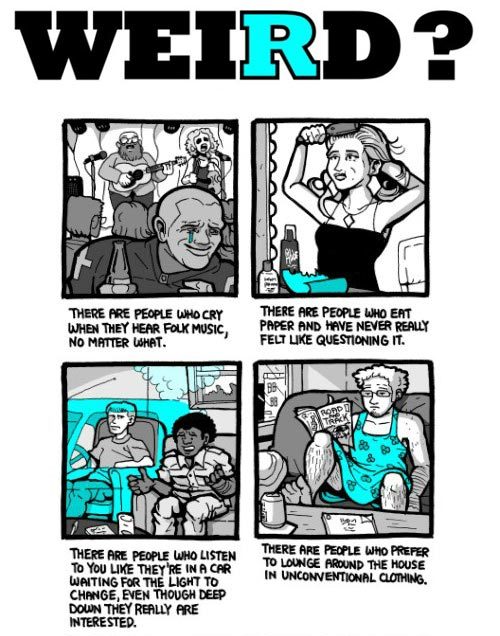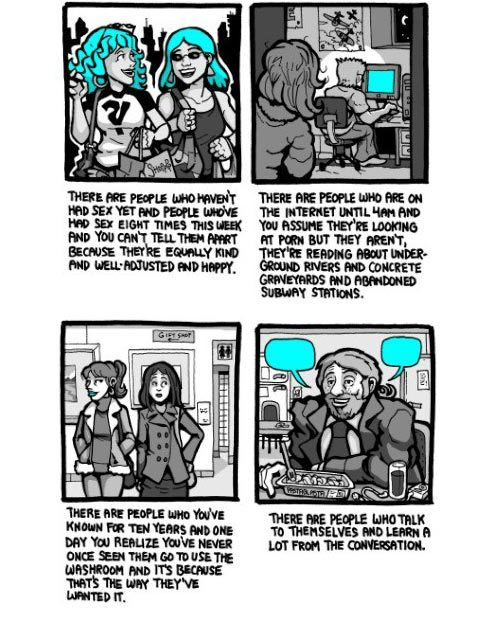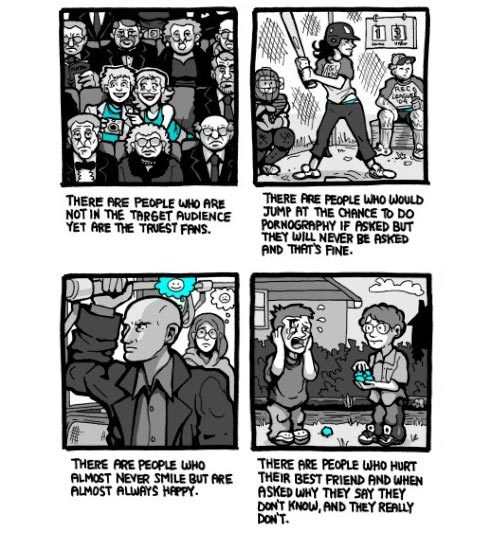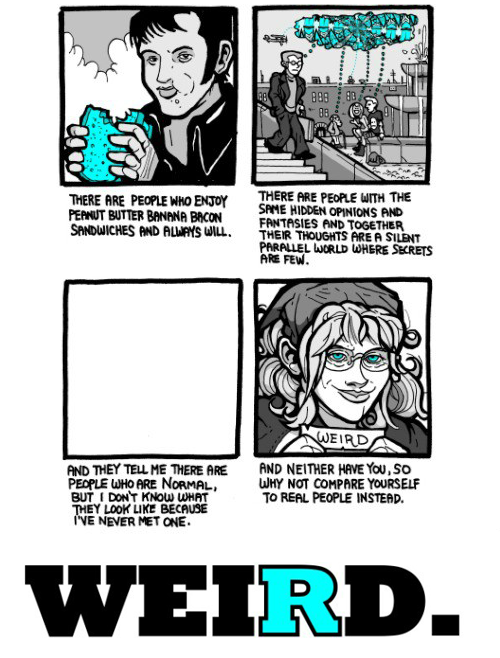    
|
iokevins
Shared posts
Why the most horrible apple in the world is also the most grown
In Japan, a new hairdo idea: "Ripe Tomato"
 Brian Ashcraft at Kotaku blogs about a neat idea for a hair style from a stylist in Japan. It's called "Ripe Tomato" ("kanjuku tomato" or 完熟トマト), and was created by "Hiro" at a salon in Osaka called "Trick Store", in the trendy Amemura district. Read: You'll Never Forget Japan's Tomato Hairdo.
Brian Ashcraft at Kotaku blogs about a neat idea for a hair style from a stylist in Japan. It's called "Ripe Tomato" ("kanjuku tomato" or 完熟トマト), and was created by "Hiro" at a salon in Osaka called "Trick Store", in the trendy Amemura district. Read: You'll Never Forget Japan's Tomato Hairdo.
    
|
The best interview with Neal Stephenson you've ever heard
Over on Slate's Future Tense, the brilliant internet law professor Tim Wu has just launched a series of interviews with science fiction writers — and he starts with Neal Stephenson. They talk about everything from Stephenson's hope for the future to Plato's Republic. It's heady, awesome stuff.
    
|
Perfect Moment
I grab a protein bar from the stash in my desk, put my coffee next to my Wacom Cintiq 24HD, sit down in my ergonomically-correct chair and put my feet up on the hassock under my desk.
My trusty dog, Snickers, follows me into my office and finds her napping place. She likes to be where the action is, and I'm the only show in the house.
The protein bar flavor goes extraordinarily well with coffee. I take a sip of coffee, one bite of the protein bar, then another sip. It is taste perfection.
I pull the Cintiq - a computer monitor on which I draw - toward me and position it for work. I have a television strategically positioned in the corner where I can see it easily while drawing. I find a great movie that just came out and order it with the On Demand function. I grab my drawing stylus, open a file, and start drawing.
I have a strange relationship with drawing. As a child it was a compulsion, closer to OCD than art. I drew on everything, all the time. As an adult, I see drawing as work, and it usually feels that way, especially in the morning. But today I have arranged my environment so perfectly that drawing is automatic, effortless, and childlike.
The movie serves two purposes. It distracts me from an otherwise mundane task that will last a few hours. But it also causes me to take frequent breaks to see what is happening in each scene before looking away to draw. I need the breaks to keep from overworking my hand.
I'm the sort of person who needs to feel productive. When I'm drawing, I know I'm doing something useful that has a specific value. It is meaningful work and it nourishes something deep inside me. Work isn't what I do; it's who I am. When I work, I exist in a way that makes sense to me.
I also remember what it took to get to this place. I think of all the days in my youth when I worked on my uncle's dairy farm doing back-breaking labor under the boiling sun. I think of all the mornings I got up before dawn so I could shovel snow or mow lawns to earn money for college. I think of the four jobs I held during college. I think of the three years I worked my day job while going to school at night to get my MBA. I think of the six years I worked full-time at Pacific Bell while creating Dilbert morning, nights, and weekends. I think of the ten years I worked without taking a day off.
And as I listen to the sweet snoring of my loving dog, I realize that all of my hard work paid off.
I take another sip of coffee, another bite of my protein bar, and draw. It is a perfect moment.
You're All Just Jealous of My Jetpack: a collection of Tom Gauld's brilliant cartoons
My glib description of Tom Gauld's cartoons would be "a science fiction Edward Gorey." It's unfair though, because there's is only a superficial stylistic resemblance between the two writer/illustrators.
To read a Tom Gauld cartoon or illustrated book (see my reviews of The Gigantic Robot and Goliath) is to be entertained, but also to be affected on a deeper level, where timeless truths about the human condition wait for talents such as Gauld to tap a line into them and provide lesser mortals like me with a chance to taste them.
Gauld's new book, You're All Just Jealous of My Jetpack came out yesterday, and it consists of single panels that explore the passage of time, absurdism, and most of the 7 Deadly Sins, all presented with a sense of graceful whimsy that makes his work such a delight to read. Below, a sampling of You're All Just Jealous of My Jetpack.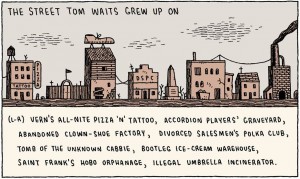
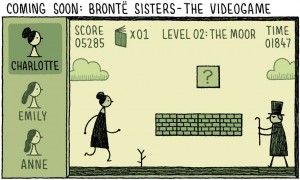
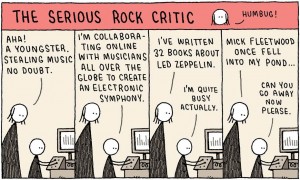

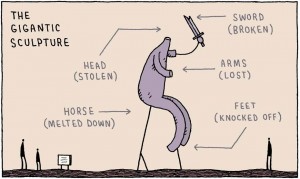
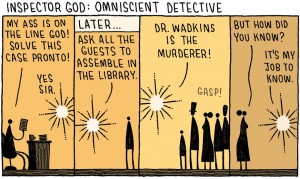
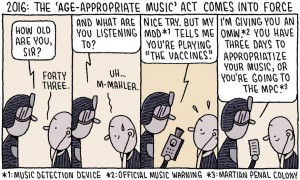
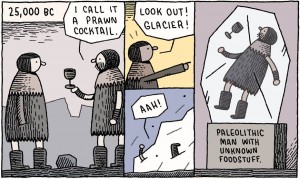

    
|
"Oxyana," new doc on how Oxycontin addiction is destroying Appalachian communities
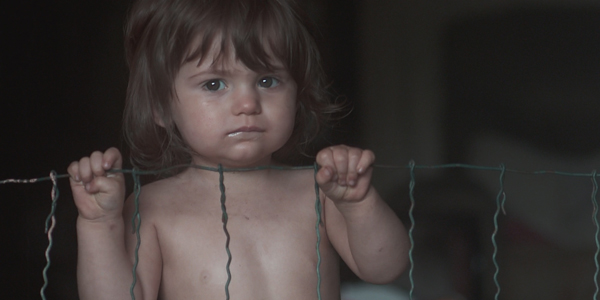 "Nothing here but Oxy and coal," says one of the subjects of Sean Dunne's new documentary Oxyana, which just won Special Jury Mention at the 2013 Tribeca Film Festival. From Capital New York's review: "The 'here' is Oceana, a once-bustling mining town in West Virginia, now decimated by Oxycontin addiction to the point where the media have rebranded it 'Oxyana.'" More at Indiewire and Cinema Blend. Dunne is the same director behind the Insane Clown Posse doc "American Juggalo." (HT: nils_gilman)
"Nothing here but Oxy and coal," says one of the subjects of Sean Dunne's new documentary Oxyana, which just won Special Jury Mention at the 2013 Tribeca Film Festival. From Capital New York's review: "The 'here' is Oceana, a once-bustling mining town in West Virginia, now decimated by Oxycontin addiction to the point where the media have rebranded it 'Oxyana.'" More at Indiewire and Cinema Blend. Dunne is the same director behind the Insane Clown Posse doc "American Juggalo." (HT: nils_gilman)
    
|
HOWTO play Tetris forever
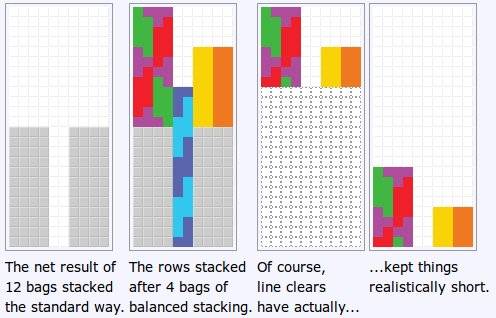
Given a standard Tetris engine (which drops pieces in a pseudorandom order, has previews, and allows holding), this method will allow you to play Tetris forever. As always, the most fascinating thing about this is the specialized vocabulary used to describe the method:
Worst case bag distributions such as H?XX?X? and H?XXX?? deserve a special mention. The first piece 'H' denotes a piece which must be placed in Hold in order to follow the STZ loop procedure. Pieces from the LJO loop are denoted by '?', and the remaining pieces are denoted by 'X'. Using 3 previews and Hold, it is only possible to see the first 4 pieces of the bag before the second piece enters the screen. This means you only see H?XX, and only know the first piece of the LJO loop. Because H must be put in Hold, you are forced to make a decision without knowing the order of the rest of the LJO loop. If the O comes first, you can follow the procedure above without problems. The rest of the time you will run into complications like this:
Playing forever (via Hacker News) ![]()
    
|
“Leaving is not enough. You must stay gone. Train your heart...

“Leaving is not enough. You must stay gone. Train your heart like a dog. Change the locks even on the house he’s never visited. You lucky, lucky girl. You have an apartment just your size. A bathtub full of tea. A heart the size of Arizona, but not nearly so arid. Don’t wish away your cracked past, your crooked toes, your problems are papier mache puppets you made or bought because the vendor at the market was so compelling you just had to have them. You had to have him. And you did. And now you pull down the bridge between your houses, you make him call before he visits, you take a lover for granted, you take a lover who looks at you like maybe you are magic. Make the first bottle you consume in this place a relic. Place it on whatever altar you fashion with a knife and five cranberries. Don’t lose too much weight. Stupid girls are always trying to disappear as revenge. And you are not stupid. You loved a man with more hands than a parade of beggars, and here you stand. Heart like a four-poster bed. Heart like a canvas. Heart leaking something so strong they can smell it in the street.”
― Frida Kahlo (to Marty McConnell)
HOWTO play Tetris forever

Given a standard Tetris engine (which drops pieces in a pseudorandom order, has previews, and allows holding), this method will allow you to play Tetris forever. As always, the most fascinating thing about this is the specialized vocabulary used to describe the method:
Worst case bag distributions such as H?XX?X? and H?XXX?? deserve a special mention. The first piece 'H' denotes a piece which must be placed in Hold in order to follow the STZ loop procedure. Pieces from the LJO loop are denoted by '?', and the remaining pieces are denoted by 'X'. Using 3 previews and Hold, it is only possible to see the first 4 pieces of the bag before the second piece enters the screen. This means you only see H?XX, and only know the first piece of the LJO loop. Because H must be put in Hold, you are forced to make a decision without knowing the order of the rest of the LJO loop. If the O comes first, you can follow the procedure above without problems. The rest of the time you will run into complications like this:
Playing forever (via Hacker News) ![]()
    
|
Former FBI Agent: All Digital Communications Stored By US Gov't
Read more of this story at Slashdot.
Create Your Own Adventure Tours by Modifying Routes on Tour Sites

Adventure tours are an excellent way to take a vacation to get to know a side of the world you'd miss by just hanging out in a city, but they're usually incredibly expensive to book through a travel agency. Over on Cool Tools, they show you how to build your own using those same itineraries.
A lot of adventure tour companies publish their itineraries, which means that all you need to do is check them out, and you have a starting point for planning your trip on your own. Cool Tools goes through a number of great places to find inspiration, including National Geographic Adventure, Zegrahm, and Wildness Travel, but the best of the bunch is Journeys International:
But of all the tour sites, the one that has provided me with the most appealing itineraries is Journeys International. They emphasize in getting you to walk, hike, bike and kayak and this is really the way to go anywhere. Almost any one of their itineraries would yield a fantastic adventure.
Remember, I have no personal experience with the tours given by any of these outfits. I only use their freely published routes. All these tours are super expensive if you buy them but I would bet they would be really fun and generally well done. I recommend them here only as models to assemble your own.
The basic idea here is to take a previously published adventure tour to find inspiration and routes, modify it slightly to fit your needs, and end up saving a ton of money. Head over to Cool Tools for the full post.
Hack Your Own Adventure Tours | Cool Tools
What Happens to Your Brain When You Have Stage Fright

Palms sweaty. Heart racing. You know the feeling. Whether it’s five people or fifty, public speaking is a gut-wrenching experience for most of us.
Before co-founding my startup, I had a huge fear of speaking in public. Any time I had to present something in front of more than a handful of people, my stomach would turn to knots and my throat would get so tight I wouldn’t be able to speak. The reality is, if you’re planning on presenting pretty much anything in your life (which you most likely will), you’ll need to be able to effectively communicate your ideas in front of at least a few people.
To get over my fear of public speaking, I realized a good place to start would be to understand why I was getting stage fright in the first place.
What is Stage Fright, Really?
Sometimes, even weeks before a presentation, I would think, ”What happens if people think I suck, or someone thinks I don’t know what I’m talking about?” As humans, we’re hard-wired to worry about our reputation above almost all things. There are primitive parts of your brain that control your reaction to threats on your reputation, making these reactions extremely difficult to control. These reactions to threats are precisely what Charles Darwin tested when he visited a snake exhibit at a zoo in London. Darwin tried to remain perfectly calm while putting his face as close to the glass as possible in front of a snake that was ready to strike.
However, every time the snake would lunge toward him, he would grimace and jump backward. Darwin wrote his findings in his diary:
My will and reason were powerless against the imagination of a danger which had never been experienced.
He concluded that his response to fear was an ancient reaction that had not been effected by nuances in modern civilization. This response is know as the “fight or flight” syndrome, a natural process that is designed to protect your body from harm.
What Happens in Our Brain
When you think about negative consequences, a part of your brain—the hypothalamus—activates and triggers the pituitary gland to secrete the hormone ACTH. This hormone stimulates the Adrenal Glands in your kidneys and results in the release of adrenaline into your blood:

It's at this point in the process when many of us experience reactions: Your neck and back muscles contract (forcing your head down and your spine to curve) moving your posture into a slouch. This results in a "Low-Power position" as your body tries to force itself into the fetal position:

If you try to resist this position by pulling your shoulders back and lifting your head up, your legs and hands shake as the muscles in your body instinctively prepare for an impending attack. Your blood pressure increases and your digestive system shuts down to maximize efficient delivery of even more nutrients and oxygen to your vital organs. When your digestive system shuts down, it leads to the feeling of dry mouth or butterflies. Even your pupils dilate, making it hard to read anything up close (like presenter notes) but improving long range visibility—making you more aware of your audience’s facial expressions.
Your Experience of Stage Fright is Affected by 3 Main Things
1. Genes
Genetics play a huge role in how strong your feelings of anxiety are in social situations. For instance, even though John Lennon performed on stage thousands of times, he was known for throwing up before going on stage for his live performances. Some people are simply genetically wired to feel more scared when performing or speaking in public.
2. Level of task mastery
We’ve all heard the saying, “practice makes perfect.” The main benefit of practice is to increase your familiarity of a given task. As this familiarity increases, feelings of anxiety decrease, and have less of a negative impact on performance. In other words, the more comfortable you are with your presentation, the anxiety you feel about speaking in public.
To support these findings, in 1982, a team of psychologists watched pool players play alone or in front of crowd. The study found that "stronger pool players sank more shots when performing in front of a crowd, while poor pool players performed worse. Interestingly, the stronger pool players performed even better when people were watching them versus when they were playing alone." What this means is if you know your presentation inside out, it’s more likely that you’ll give an even better presentation in front of a large audience than when you rehearsed alone or in front of a friend.
3. Stakes
If you’re giving a presentation where your business is on the line or the whole nation is watching you speak, there’s an increased chance that your reputation could be massively damaged if you screw up. This triggers the release of more adrenaline, and can result in paralyzing fear and anxiety. We’ve seen the effect of stakes on reputation in online communities as well. For example, many eBay sellers worry about their reputation a ton because it directly effects how much money they make. One piece of negative feedback can ruin an eBay seller’s profile and cause them to lose sales.
In fact, one study found that a good reputation for a seller on eBay added 7.6 percent to the sale price of their items. Having a good reputation is important to protect but it also leads to having a fear that one slip-up could ruin your reputation and cause the loss of future opportunities.
How I Cured Stage Fright
So now that we know the root causes of why public speaking is scary, here’s what you can do to dramatically improve and overcome your on-stage jitters.
Preparation
I’ve been to many conferences where I see speakers organizing slides a few minutes before their talk. That’s not the optimal way to prepare for a quality performance. Would you see a musician learning their song 10 minutes before going on stage to perform it? No way. This way of preparation is also not fair to your audience who is giving the next 10, 20, or 60 minutes of their attention to you. When I’m preparing to give a presentation or a talk at a conference, here’s my process:
About a week before, I draw out a storyboard of 15-20 slides, thinking over the content using stick figures or a few words that I may put on my slides. Here’s one of my storyboards:

Creating this storyboard helps me feel comfortable with the major points I want to cover and still leaves me plenty of time to rehearse and perfect slides. I then layout my talk like this:
introduction
main topic 1
point
example (something unique from my experience)
point (with key actionable takeaway)
main topic 2
point
example (something unique from my experience)
point (with key actionable takeaway)
main topic 3
point
example (something unique from my experience)
point (with key actionable take away)
conclusion
Formatting your talk in this “point, example, point” format not only helps you visualize your entire presentation but also allows you to think deeply about the subject matter you’re covering so you don’t leave your audience wanting more. I start by filling in each main topic point first and then skip back to the introduction and finish with the conclusion.
When working on the introduction, I start with a story that covers who I am and why the audience should care about my talk. Tell your audience right away how you're going to help them so they tune in. I then rehearse each of these individual parts (introduction, main topic 1, main topic 2, etc.) between 5-10 times each. Once that’s done, I recite the presentation content from start to finish at least 10 times.
This might seem like a lot of preparation but keep in mind, Steve Jobs was known to rehearse for hundreds of hours and prepare weeks in advance for his epic Apple keynote presentations.
Practice Like it’s the Real Thing
While preparing your presentation, set up your environment in the same way you plan on giving your actual presentation. This removes unknown variables and requires you to spend less mental energy thinking about details when you’re on stage for the actual presentation. In 2009, a group of MIT researchers found that when there are many visual stimulants in front of you, only one or two things tend to get activated in the brain, indicating that we’re really only able to focus on one or two items.
You want to get to a point where all you have to focus on is connecting with the audience and enhancing the delivery of your story, rather than worrying about what slide is coming up next or where you need to stand on stage. When I’m rehearsing, I set up my computer on the same side it will be during the actual presentation, I use the same clicker, and I deliver my presentation every time as if it were the real thing.
Another tip to help prepare for unknown variables is to say your presentation in front of someone or at least record yourself to replicate the effect of someone watching you. This will help you feel less anxious when you get up in public, knowing that you’ve already said your presentation in front of at least one person.
Learn to “Breathe Into Your Balls” (This One isn't Just for Guys!)
The most nerve-racking part of public speaking for me is always those last few minutes before heading on stage. What do I do to combat those feelings? I head into the bathroom, stretch my arms up, and take three deep breaths in and out. Elliot Hulse, a YouTube-famous fitness-expert, calls this “breathing into your balls." He recommends this as the first and foremost way to avoid being anxious before a meeting or giving a speech. Here's Elliot in action:

This exercise activates the hypothalamus, and sends out hormones to trigger a relaxation response. In fact, researchers tested a single session of slow breathing on 46 trained musicians and the results of the study found that one session of slow breathing helped control arousal, especially for musicians that had high levels of anxiety. The feelings associated with stage fright are usually the strongest during the lead-up to the presentation rather than during it, so take a minute to breathe and stretch before heading out on stage.
Book Another Speaking Engagement Right Away
If you want to get better at public speaking, you have to do it more. Each time you speak, you will get less nervous and more comfortable. At first, try to book speaking engagements that have lower stakes. Maybe it’s a presentation to your family members about the importance of taking a vacation. Anything to help you rehearse the behavior of getting up and speaking in front of people.
Quick Last Tip: Stop Saying “Um” and “Ah”
A few “ums” or “ahs” won’t kill your presentation, but if they begin to fill every slide transition or pause between points, they can become a distraction. Training yourself to stop saying “um” or “ah” can be difficult, especially if it’s a part of your everyday speech.
One of the best ways to knock these filler words out of your vocabulary is to use a technique called chunking. Chunking means splitting your presentation up into short bursts of words followed by a short break, and then continuing on with another short burst of words. For example, group 1-2 related sentences together followed by a 1-2 second pause, then another 1-2 sentences, and so on. This will help you develop a speaking rhythm, making it easier to avoid filler words.
What happens to our brains when we have stage fright: The science of public speaking | Buffer
Mikael Cho is the co-founder of ooomf, a creative marketplace that connects awesome projects with vetted, first class developers and designers from around the world.
Illustration by Tina Mailhot-Roberge.
Want to see your work on Lifehacker? Email Tessa.
Stuff I Like: Guy Clark
I was going to begin this new semi-regular weekly feature a little less than a month or so ago, but events in Boston got in the way, and it didn't seem appropriate to launch some new fun stuff while people with really big guns were still chasing the Tsarnaevs all over Middlesex County. It always has been the guiding principle of the blog and before that, of whatever newspaper column I was writing that this is my place. I decide what gets hung on the walls. I decide what gets served for dinner. I decide what music gets played on the sound system. You don't like my art, my food, or my music? Build your own place. Anyway, I thought I'd reserve a semi-regular spot for my erratic enthusiasms and then you all can fight about it in the comments and I can have some fun watching you from the back porch of my ivory tower.
In the spring of 1989, my father was in the last, lingering throes of Alzheimer's Disease, which is to say that, because he had forgotten how to swallow properly, he was in the midst of serial pneumonias, the last of which would kill him. I spent a lot of hours keeping vigil in a chair in his hospital room, and then in one of those big leather things that they use for patients in his room at the Alzheimer's unit where he'd been living for a time. I had two regular companions during those long nights a mountainous book of American political history, and this song right here, which I played over and over on my Walkman, especially late at night...
gtdguy: @jamesloleary James, I love hearing about folks who catch the deeper messages, reflected in Ready for Anything. My favorite book, actually.
Watch “The TED Talk That Might Make Every Man a Feminist” [VIDEO]
This TED talk, delivered by Jackson Katz, Ph.D to TEDxFiDiWoman, is being called “the TED talk that might make every man a feminist” (Rebecca Eisenberg, Upworthy) If wishes were fishes, eh? Cynicism aside, Katz has a lot of good things to say about domestic abuse, sexual harassment, and other forms of gender violence, and the responsibility of men—not just those who commit it, but bystanders as well—to put an end to it. It sounds simple, but it’s something that’s often missed when gender violence as framed as a “women’s issue” (as if it’s not the behavior of the perpetrators that needs to change).
The talk took place back in February, but even though it’s a few months old I think it’s well worth a listen. I hope you think so, too.
(via: Skepchick)
Are you following The Mary Sue on Twitter, Facebook, Tumblr, Pinterest, & Google +?
How to Dual Boot and Virtualize the Same Partition on Your Computer

Can't decide whether you want to dual boot that second OS or virtualize it? Debate no more: you can have both. Here's how to dual boot and virtualize the same partition on your Windows PC or Mac.
What Bad Posture Does to Your Brain

We've heard countless times that good posture and ergonomics are necessary when you're working at a computer, but what exactly happens when you don't follow those tips? The Wall Street Journal found out.
As it turns out, a lot changes. It's not just in your body, it's also psychological:
It's not as though slouching will give you a hunchback in a day, but "if you do this day after day, and your muscles are not strong, the whole skeleton changes," Dr. Golubic says. "I'm not aware of any studies that look at the changes in the volume of organs like the liver and spleen when you sit straight or slump forward. But we do know that when you slouch, you project an attitude of depression and low motivation." When you sit up straight, he adds, "psychologically, your attitude is better."
Thankfully, improving your posture is pretty easy. You can test your posture against a wall, and ergonomically optimizing your workspace will help as well. For their part, The Wall Street Journal also recommends keeping an eye out for lower back pain as an indicator for poor posture, and considering something like yoga to improve your sitting position.
Burning Question: Why Sit Up Straight? | The Wall Street Journal
Photo by Charles Hutchins.
Documentary on sexism in gaming industry surpasses crowdfunding goal

By Megan Farokhmanesh on May 05, 2013 at 4:00p
GTFO, a documentary about sexism in the video game industry from New York-based filmmaker Shannon Sun-Higginson, surpassed its $20,000 funding goal.
The film's intent is to expose "the harassment of women in video games" though developer, blogger, player and scholar interviews. Sun-Higginson, who self-identifies as a casual gamer, wrote on the Kickstarter page that she was "shocked" at the amount of abuse female gamers take on a daily basis and began researching and filming GTFO as a result.
"The purpose of this documentary is to reveal the experiences of women in the gaming world, both good and bad, as well as to provide steps we can take to change the environment for the better," the Kickstarter page reads.
GTFO reached its goal May 1 and will continue to raise funds until May 10. Those interested can donate in reward tiers ranging from $10 to $500. Funding will go toward shooting expenses, post-production, licensing rights for gaming footage and images and promotional materials.
The fundraising campaign for GTFO launched March 26. At the time of this posting, it has raised more than $22,000 with the help of 800 backers.
Two months aboard an Antarctic ice breaker, condensed to 5 minutes
Here's an incredibly cool video showing the prow of a massive ice breaking ship as it plows through Antarctica's Ross Sea. The footage is sped up, to pack two months of travel into five minutes. But, unlike a lot of time-lapse videos, this one also has a really informative audio track, in which marine scientist Cassandra Brooks waxes poetic about the many different kinds of ice and explains why she and her team were out there, breaking through the stuff, to begin with.
Bonus: At the end, you get to see the absolute adorableness that is penguins on high-speed fast forward.
Via Deep Sea News
North American English Dialect Map
Samsung Galaxy S4 in the flesh polycarbonate
Recently we received the first of several Samsung Galaxy S4s for the Ting help desk and test lab. Yesterday, we asked the Ting Facebook community what they’d like us to demonstrate in video form.
Samsung Galaxy S II, S III and S4 compared
First, we took a look at the physical differences between and evolution of the Galaxy line of devices.
New features and the camera on the Samsung Galaxy S4
The Samsung Galaxy S4 carries over some of the useful S- features from previous devices and introduces a several new ones.
The camera app on the Samsung Galaxy S4 has been very much overhauled too and includes a veritable cornucopia (always wanted to say that) of new features and additions.
Subscribe to the Ting channel on YouTube to get the latest video updates as they hit. If you’ve got any video requests, things you’d like to see on the Samsung Galaxy S4 juse let us know and we’ll do our best to get a video for you.

